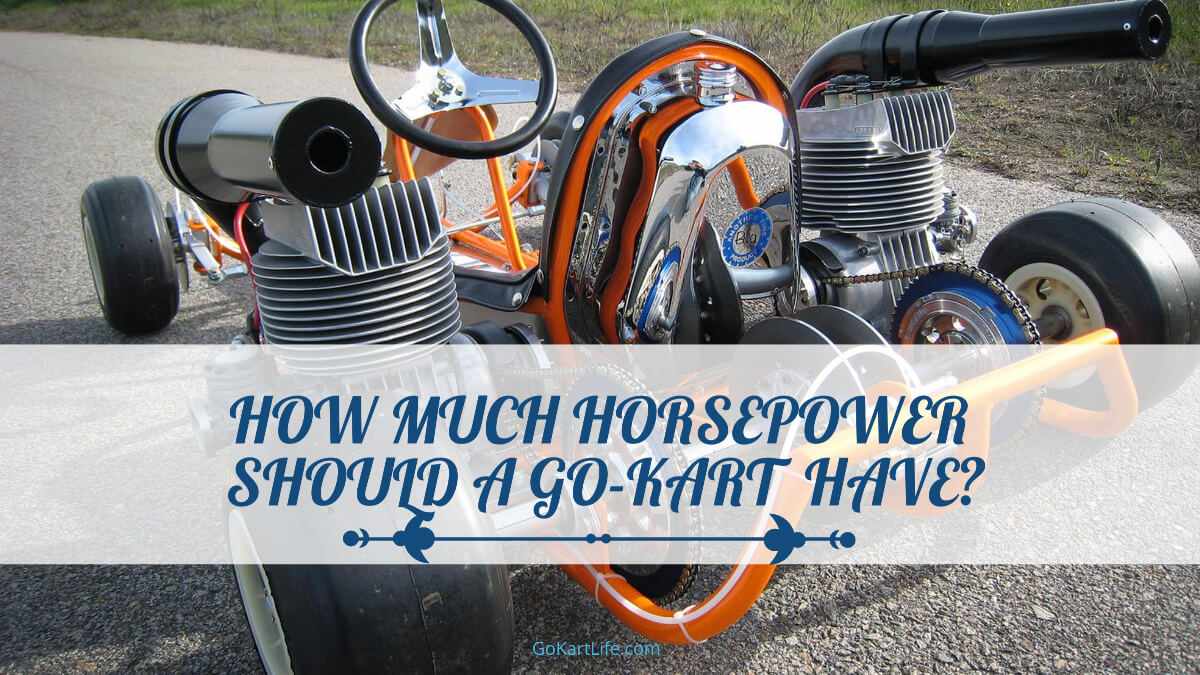Go-karts provide an exciting, engaging hobby for people of all ages. Whether you’re building a small cart for a kid or a high-HP model for an adult, you’ll experience a few troubles along the way. A go-kart’s horsepower directly impacts its speed, acceleration, and handling. Too much horsepower can cause all sorts of problems.
How much horsepower a go-kart should have depended on the rider’s age, size of the cart, and whether it’s an indoor or outdoor model, usually from 4 to 16 horsepower. Be sure to know your go-kart track’s horsepower limitation before installation to avoid burning your tires.
In this article, we’ll cover the horsepower recommendations for indoor and outdoor go-karts. We’ll also talk a look at the pros and cons of high vs. low horsepower go-kart engines and the problems associated with too much horsepower.
Recommended Horsepower for an Indoor Go-Kart
Are you interested in racing on indoor go-kart tracks? They have unique requirements and recommendations, especially since they’re often smaller than outdoor tracks. Always contact the management team before choosing a horsepower. Your go-kart’s horsepower is one of the most important decisions to make.
So, how should you choose horsepower for an indoor go-kart?
Indoor Go-Karts Should Be Between 5 to 13 Horsepower
Many indoor go-kart tracks suggest getting a go-kart between 5 to 13 horsepower. Consider how fast you’ll be driving, how many turns there are, and so on. If you’re a beginner, always choose a lower horsepower since you might not be used to the speed and acceleration. Although it seems low, five-horsepower is quite powerful in a lightweight go-kart!
Low-Horsepower Go-Karts Are Often a Better Choice
Why would someone choose a low-HP engine over a high-HP model? There are several reasons to pick five to eight horsepower over anything above ten. For example, low-HP go-karts offer better handling, a tighter turning radius, and a drastically reduced chance of skidding or burning out when the race starts.
Consider Your Go-Kart’s Weight for the Horsepower
The heavier the go-kart is, the higher the horsepower should be. There’s a limit to the horsepower (typically, anything over 22 HP is rare but not unheard of). If you have a heavy go-kart, you might want to think above, leaning toward 10 to 13 horsepower when racing on an indoor track.
As you can see, choosing the horsepower for an indoor go-kart track is quite simple. Slow and steady wins the race. If there are lots of turns, you’ll almost always be ahead of the competition. However, outdoor tracks are a different story. For more information about what horsepower you should choose for an outdoor go-kart, proceed to the next section.
How Much Horsepower Should Your Outdoor Go-Kart Have?
Those looking to race outdoors will have a much broader horsepower range. The track’s size, terrain, width, turning radius, and many other factors will affect your decision. It would help if you also considered your tires and the width of your go-kart since it’ll impact how easily you can turn the vehicle at a moment’s notice.
Here’s a list of considerations when choosing a horsepower for an outdoor go-kart:
- Contact your favorite race tracks before determining the horsepower. Nobody wants to create the perfect go-kart and then have to change it on race day. Fortunately, most race tracks list their horsepower limitations. Anything outside of their recommendations should be off your list.
- Most outdoor tracks recommend between 4 to 16 horsepower. It’s a much bigger range than indoor tracks because there are far more factors. If you’re on a hilly track with mud, you might want to choose a higher horsepower to climb the elevation and rip through the dirt.
- Some go-karts go over 22 horsepower. Karting Concepts explains a 22-HP go-kart is quite impressive, though it’s not allowed on many courses because it’s too powerful. However, there’s still a lengthy list to bring your high-power go-kart, so why not enjoy the fast-paced environment? If you’re an experienced driver, it’s worth trying!
- Consider switching engines or building two go-karts for multiple tracks. You could have different engines if you’re stuck between indoor and outdoor go-kart tracks. Switching the engine might become tedious so you could build another go-kart. Either option presents challenges, but it’s nothing new to a hobbyist.
- The terrain directly impacts your go-kart’s speed, acceleration, and horsepower. Mud, weather patterns, elevation changes, asphalt, and nearly everything else will change how your go-kart operates. A high-HP model can handle hills, mud, and more. However, smooth tracks often call for low-HP go-karts since they don’t skid as much.
It’s hard to pinpoint the perfect horsepower, but these guidelines will keep you within the most recent recommendations. The best way to know what’s suitable for your go-kart is to test it at a local track. Before racing or purchasing the engine, please give it a test drive using a friend’s or a rental.
Related Article: Discover The 10 Best Off-Road Go-Karts For The Ultimate Adventure!
Why Shouldn’t You Max Your Go-Kart’s Horsepower?
Choosing the most powerful model with the biggest engine, largest tires, and bulkiest setup might be tempting. However, there are dozens of drawbacks to choosing incredibly high-HP go-kart engines. They’re more than ideal for some tracks, but it’s worth considering the cons of these modernized engines.
Read these five considerations before upgrading your go-kart’s engine:
- High horsepower can cause your go-kart’s tires to burn out. According to GoKart Guru, many go-karts burn rubber if they have a high-HP engine. The speed and acceleration are too much for the tires to handle, so they spin in place and rip apart. Popped tired or flats aren’t uncommon in these situations.
- It makes turning much more difficult, especially on courses with tight turns. You’ve probably experienced this issue when driving a car. Sudden sharp turns are nearly impossible since the momentum pulls your go-kart far away from the turning point. You’ll drift rather than keep up with the pack.
- Some race tracks ban high-HP go-karts for various reasons. You should avoid choosing a horsepower far above most local tracks’ recommendations. It’ll be a waste of time, money, and energy, so keep the horsepower within our above suggestions.
- Go-karts aren’t designed to handle extreme acceleration and speed. They’re far too small for anything close to the same horsepower as cars, trucks, SUVs, etc. Choosing a 5-HP engine for your go-kart might seem silly, but you’d be surprised by its power for such a lightweight vehicle.
- Higher horsepower engines often add more weight, taxing the whole vehicle. You’ll end up slowing yourself down or overwhelming the go-kart’s internal components. Neither scenario is ideal, so don’t choose a horsepower that’s too big for your go-kart. The cons far outweigh the pros.
High-HP go-kart engines are often extremely fun. If you’re not following a track and want to enjoy an off-road experience, a high-HP is more than welcome, as long as it doesn’t strip the tires.
Related Article: How Fast Can A Go-Kart Go? Top Speeds Of Different Go-Kart Types
Conclusion
Now that you know how much horsepower your go-kart should have, you can choose the best option for the track. Going too high isn’t the best decision because it can burn the tires, mess up the engine, or ban you from numerous race tracks. On the other hand, low-HP go-karts are often slow but offer better handling.
Here’s a quick recap of the post:
- Your go-kart should have horsepower between 4 to 16.
- Many high-end go-karts come with an 8 to 13-HP engine.
- Indoor go-karts often need lower horsepower since the courses are shorter.

Goran, an experienced go-kart racer, fuels GoKartLife.com with his passion and expertise. He offers valuable insights and tips for fellow enthusiasts, fostering the growth of the go-kart community. Join Goran at GoKartLife.com and immerse yourself in this exhilarating sport.

